So, a long, long time ago there once was a game called Buzz Aldrin’s Race into Space (BARIS), a very challenging space program manager game set in the Cold War, not like Kerbal Space Program but more like a turn-based board game. It was a hard game with difficult challenges and plenty of random factors thrown in that could make or break your space program in a single turn, and pressure was always high on the player. Should they launch their craft early while the safety rating is lower to beat the other side to a prestige first, or should you hold back and wait, ensuring the mission is a success but maybe stopping you from getting that vital first?
Not too long ago I did a review on BARIS, and shortly after the sequel was announced. Now, I’ve got my mitts on the game and with fond memories of nervous finger biting and space flights in my mind, I set off back to the sixties to see if Buzz Aldrin’s Space Program Manager was a successful mission to be celebrated, or a violent and explosive failure to be mourned.
The Glorious gameplay of the Soviet Space Program
Functionally, the gameplay is almost identical to that of the game’s predecessor, but has a number of additions, most of them good, but a few…questionable ones. But let’s start with the good. The game’s campaign has been split into two options – you have the first option which is basically the exact same as traditional BARIS; you can choose to play the USSR or the USA and race against the opponent with the ultimate goal being to send men to the Moon and bring them home safely. In the second option, you lack any opponents whatsoever, instead competing against objectives set by the administration of the Global Space Agency, the GSA. In the first option, you have access to all the objects your nation actually sent up in the game’s time period, while in the second you have access to everything the USA and the USSR sent up. All three have a different space port, music and so on.
Now for a bad fact to even out the good. You might recall that a few months ago, it was mentioned in a news post that, almost as a direct result of my preview while the game was being developed, they added multiplayer to the game after I mentioned just how much it added to the original game. Unfortunately, the only form of multiplayer this game has is play by email, which is easily the most finicky multiplayer system ever put into a game. Oh, of course it has its uses, especially when playing games with people from different time zones, but in my opinion, that really isn’t the strength of BARIS or its sequel, BASPM. One of the most enjoyable parts about the game was playing it alongside other people in hot seat mode, celebrating our successes and mourning our failures together and the game has really lost something by not making that possible, especially considering its state as a board game. No matter how good you make the AI – and the SPM AI seems a little less willing to gamble than its predecessor – they can never quite compare to a real human being.
One of the best additions to the game is the incorporation of scientists, engineers, technicians and mission controllers as actual characters with stats, wages and so on rather than just an arbitrary button to click like in BARIS. Here, you actually need to choose who to hire based on their skills, which can be further refined by advanced training, then assigning them to different programs best suited for them. Mission control is the exact same, but instead you assign the different controllers to the various stations on the launch of the craft, which then serve as modifiers to the various success rolls that occur during a mission, which we’ll talk more about later.
This might be a relatively minor feature in the greater scheme of things, but it adds on an entirely new layer of strategy onto the management of personnel; do you keep your scientists at work with their current skill levels, or do you send them to advanced training, losing access to their skills for a few seasons while they improve, giving you better research in the long run? And speaking of research, there are a ton of different objects in game to choose from, some of them theoretical projects that never left the drawing boards, others that failed with explosive results and others every school child could recognize today, like the Apollo capsule and the Eagle lander. Each and every object has a lengthy post written by Buzz Aldrin himself, with tons of historical facts and technical information for the player to read. This is a real treasure trove of information, and any spacecraft junkie will certainly enjoy the wealth of data just sitting at their fingertips.
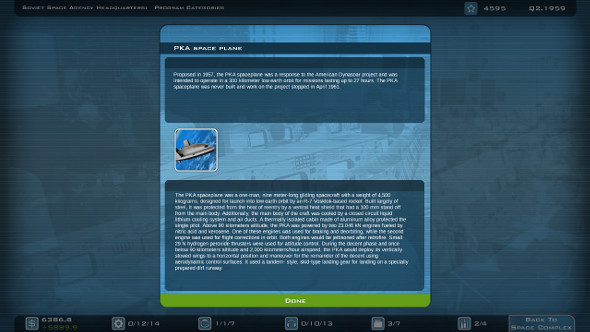
Interestingly enough, this craft has already flown in atmosphere in my game successfully even though it was never built in real life. Alternate history time!
Most of the game mechanics, like safety ratings and item programs, are the exact same as they were in the original game and the acorn certainly didn’t fall far from the tree. Indeed, so similar is the safety rating system and mission objectives system that I could safely say that if you read that part of the original BARIS review, then you know exactly how that part of the game works. Just like in BARIS you buy a payload and rocket, assign it to research and watch the safety rating improve before sending it out on a mission to see if it goes boom in a good way or a bad way. Each craft has a ton of missions and some crafts from different programs use the same hardware, however, like the Vostok and the Korabl-Sputnik.
After a mission is successfully completed, you receive a couple of reward badges that show you just what was accomplished on that mission and gain prestige – which is your main way of telling how successful you are so far. You see, your government will assign you targets to complete in prestige, which will determine your seasonal income at the next review. A particularly great success will give a ton of prestige and a horrible failure – worse if it gets someone killed – will take away a lot of prestige! The main goal of the game is to beat the other side to the moon and then come back safely, but there are many other missions to be completed that will give you plenty of needed prestige – like sending a probe to the Sun as the USA or putting a rover on Mars as the USSR. While these might not contribute much to your goal of landing a man on the Moon, the prestige they generate can be essential to getting the funding you need to carry out your primary objective.
And to proceed with your primary objective, you need to…
Launch rockets: the game in action
Once you have selected the hardware to use, developed it to a level you believe is safe enough and have trained your personnel, it is time to launch your craft and see the game in action. Whenever you launch a rocket, just like in the original game, you get a nice cinematic showing the flight and the different results in the bars at the bottom showing just how well things have gone, and just how close they might be, too. This is where the game’s board game origin really shines through – for each step of the flight, your safety rating is challenged by a random number. If it is the same or less than that number, then everything is fine. If that challenge surpasses your safety number…things have gone wrong, and your mission controllers and cosmonauts will attempt to salvage the mission, either aborting it early such as in the case of a duration failure or completing the mission regardless of the fault. Otherwise, if they fail or if the gap between your safety rating and the challenge is too high, then things go boom, resulting in the loss of crew and cargo.
Scheduling a mission is as easy as going to the headquarters, selecting the program and the hardware and just clicking schedule mission. The assessment button is a handy little tool that makes suggestions on whether or not the craft is suitable for launch, but it is ultimately up to the player when to launch and what to launch their people in. It will also tell you what goals will be achieved if it is a successful mission, and gives you precious information about the cost and the various personnel required, most important is whether or not it is a manned mission. Once that is done, you assign flight controllers…
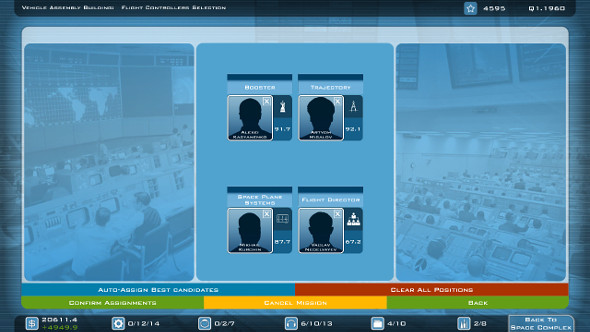
Their faces have been redacted in case the evil CIA try to assassinate the hardworking flight controllers of the Space Sector Soviet Socialist Republic.
Finally, you assign a crew to the craft, in this case one cosmonaut to serve as pilot, and then everything is ready for the launch as soon as the craft is prepared. The many screens of this game are easy to navigate through thanks to the simple user interface, making life a little easier for the players. Finally, after ending the turn, you will be given the choice to abort the mission or not, the last chance to get out before things get dangerous. You see, either by design or due to a glitch, even a minor mission failure, like an error in pre-flight checks…results in the death of the cosmonaut on board the craft. You’ll be given a chance to skip the cinematic (which is part of the very core of the game, so I’d advise against it unless you’re in a hurry) and then lastly, you’ll be ready to watch the flight, where everything comes together as one. Rather than giving you guys a bunch of screenshots, here’s a video!
Our mission was a success, and so we got plenty of prestige points and an upgrade to the safety rating of each of the craft used in the mission, which would allow us to get even more funding at the end of the review season. But, more importantly, we beat the other side to a major prestige first: the first man in space. Personally, I’m not a fan of the art style we see during the launches, I prefer the actual footage you see inside BARIS, but considering the fact that a lot of these craft either never existed at all off the drawing boards or were never used in that kind of mission, it’s definitely something I can live with. I also think the stages are a little too fast paced to build up much tension, something that was so thick you could cut the air with a knife back in the original game. But with most of the game play cycle now covered, it’s time to bring this review to a close.
Conclusions : Go flight?
When I said the acorn did not fall far from the tree, I meant it. This game is an enlarged and enhanced version of Buzz Aldrin’s Race into Space, a true sequel if there ever was one, and something the game was sorely needing. But the game didn’t innovate all that much – it simply added on logical upgrades, such as more content and the extra personnel departments, as well as that nightmarish monstrosity of a multiplayer system. But there is one thing to remember: this game has two expansion packs planned, and I’m sure they will be able to fix the issues that are found in this game, and looking at the game files it certainly looks moddable. But, there was one thought that made itself very known to me as I played through the game: everything is rather bright, the music can be a little over the top and the UI is so simple.
And then it hit me like a meteorite.
The game is intended for younger audiences, children and teens with an interest in spaceflight but too young to play something complex like Orbiter or Kerbal Space Program. That really suits the game’s strengths well, and while the game is easy enough that a child could play it, there’s enough depth for an adult to be able to enjoy the game too, and anything that encourages children and teens to learn more about spaceflight, science and engineering is certainly good. After listening to what Buzz Aldrin said about the game, it has certainly achieved the goal it set out to fulfill. But if you’re wondering whether or not to buy the game, go give Buzz Aldrin’s Race into Space a go – it’s free, and similar enough for you to know whether or not you’d enjoy blasting off into space in the sequel.
|
Space Sector score:
8.1/10
Great
|
|---|
The Good:
|
The Bad:
|
Chris Salt, otherwise known as CaekDaemon on Space Sector and on numerous other forums, has grown up around strategy games and has a seasonal taste in games, with genres coming and going like the weather, but a constant remains, his love of strategy games in all forms. He loves writing in all forms, reviews, books and the occasional forum game or AAR, and would love to write more reviews and previews and more for Space Sector.
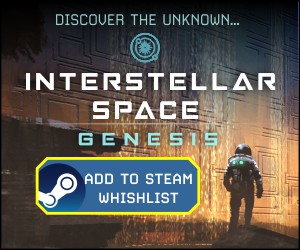
5 Comments
Related Articles:
- Buzz Aldrin’s Space Program Manager – Beta First Impressions
- Buzz Aldrin’s Race Into Space Review
- Buzz Aldrin’s Space Program Manager Giveaway Contest! [RESULTS]
- Buzz Aldrin’s Space Program Manager to Launch in October
- Buzz Aldrin’s Space Program Manager: Road to the Moon Go!

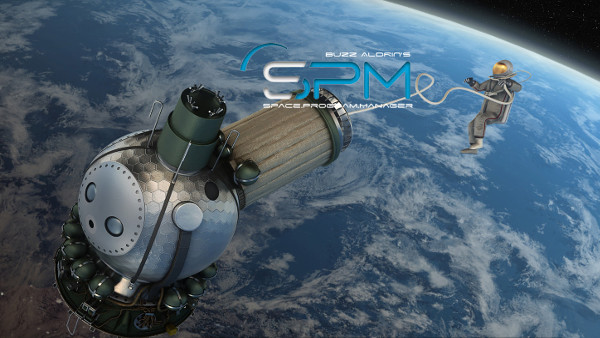
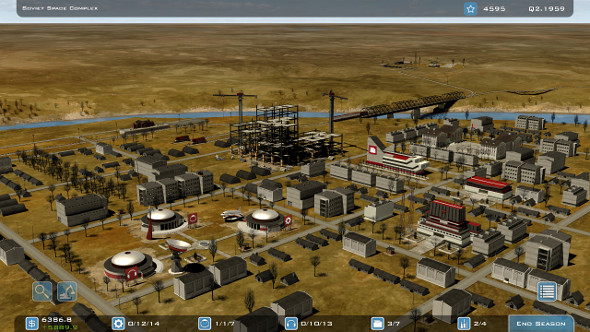
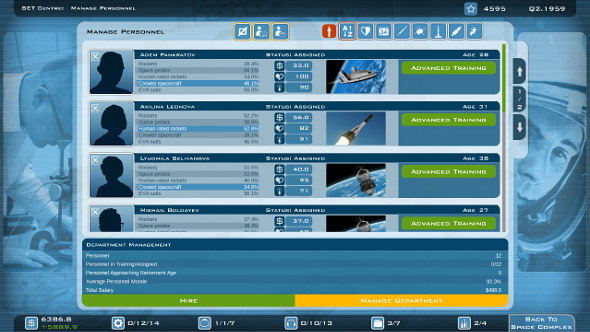
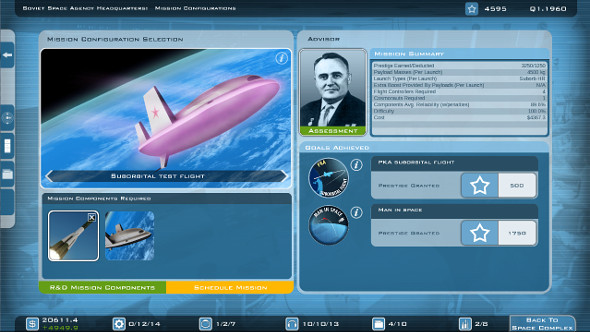
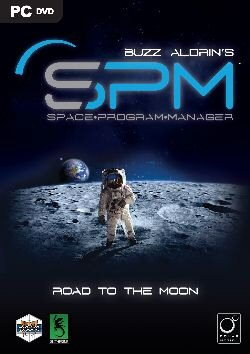
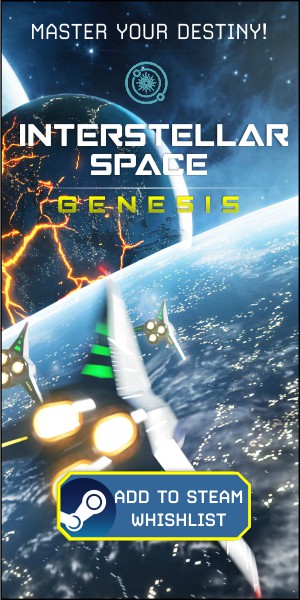





Also played the original and bought this one with high hopes… and your review reflects my point of view perfectly! It feels just like the old one did… a trip down memory lane indeed, and a good one too.
I don’t know if it will be a success among the youths, but it would be great to know that the younger generation is also capable to find this great (and real) adventure from the past as interesting as it is for us, old baby boomers.
Somehow I think they would need a little push in the right direction to even start playing this one… but if only a few of them appreciate it then it will be Worth it!
A fair review. The last paragraph is especially apt, as I could easily see this game in schools. I myself loved reading all the text about the hardware and programs as I played through the final version of the game.
However, there was one problem that your review did not mention. As you can see in that third screenshot, there are almost no headshots of the personnel! In fact, the only one who has a headshot is Buzz Aldrin himself (if he shows up in your recruit pool). This is weird, as I can remember a few headshots from earlier betas of the game – and user-submitted headshots were one of the rewards of the buy-in program. I wonder what happened there?
Surprisingly positive review but I guess because the author is a fan of the original. I never played that one so I wonder if I would enjoy this one or not as it feels and looks a bit too simple for my taste. I really enjoy Kerbal Space Program especially with all its mods out there. I am not sure if I would really this one as well or maybe it would be better to wait for the add-ons and then make a decision? Or play the original (although it looks really really dated now) first! Any suggestions?
I have to disagree that some people are “too young” to play complex games such as KSP or Orbiter. I have to disagree that the grown-ups “have” to play complex space games.
In truth, some people prefers to deal in general control of NASA itself, rather than dealing with technical details in KSP such as calculating the periapsis and the apoapsis of the flight. BASPM and KSP are different genres of game, one is focusing on the tycoon and managerial aspect, and the other are focusing on the technical aspect. One is more akin to Airline Tycoon, one is more akin to Flight Simulator.
In other parts, I have to add that this game is a great game.
You make a good point, they’re really not the same kind of game at all (despite the similar subject matter). The debate of “Why should I get SPM when I already have KSP?” (or more occasionally the other way around) is tiresome.